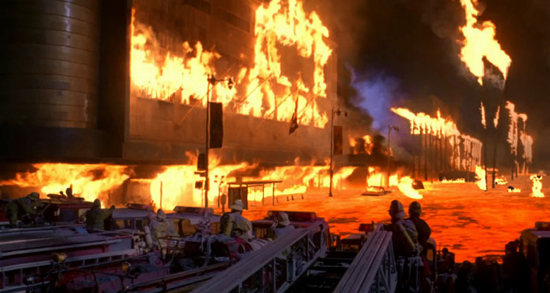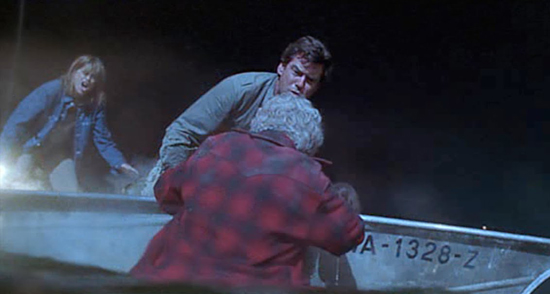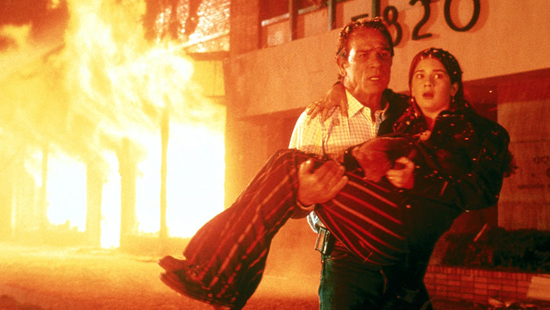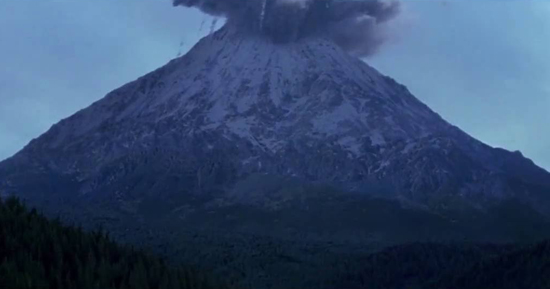
The disaster film has had many ups and downs throughout the history of cinema; mostly downs. Sure, you have your Oscar-winner Titanic (1997), but most of the time the genre is marked by many sub-par efforts that either end up laughably bad (1996’s Twister) or just plain bad (2004’s The Day After Tomorrow). And the common fault with most disaster films isn’t whether or not they can make the disaster appear real or not; in fact, most of the time, these types of movies are wonderful showcases for the best advances in visual effects. No, the thing that most of these types of movies struggle with the most is how they tell their stories. In reality, disasters as a moment in time are quite brief. Usually when a movie tackles something like an earthquake or a tornado as a part of their story, they have to film the run-time with a lot of extra filler, because those natural occurrences last minutes at the most. There are ways around such problems. Movies like Twister and San Andreas (2015) manage to keep the story momentum going by making their films not just about one disastrous event, but a whole string of them. And movies like Titanic and The Poseidon Adventure (1972) get their dramatic tension not from the incident itself, but from the aftermath, and all the desperation that comes about from the characters trying to survive. It’s easy to forget that the human drama is the essential part of any disaster movie, and oftentimes these movies fall apart because the filmmakers seem so disinterested in their stories. The worst kinds of disaster movies are usually the ones where human beings are treated purely like lambs to a slaughter, except whichever character the bankable movie star is playing, as they somehow miraculously survive without a scratch. This is a genre that has many different types too, with no natural or man-made disaster seemingly unexplored, and there was a period of time when the genre was so prolific that it often resulted in direct competition with like-minded films.
This was the case in the late 90’s, as digital effects were starting to become a more useful tool in Hollywood. Though the genre saw a renewed interest in this decade, it’s roots go back further. Disaster movies were always brought out the best in big screen entertainment, and even the early days of the talkies saw it’s fair share; like San Fransisco (1936) where Clark Gable and Spencer Tracy survive through the 1906 earthquake, or In Old Chicago (1937) where Tyrone Power and Alice Faye try to endure the Great Fire of 1871 that consumed the city. But the genre didn’t hit it’s peak until a producer named Irwin Allen stepped into Hollywood during the 1970’s. Not only did Allen develop films that utilized the best visual effects available at the time, but he also invented the idea that these disaster films should also include all star casts as well. With movies like The Poseidon Adventure and The Towering Inferno (1974), Allen made the disaster film not only the most visually stunning productions of their time, but also the most star studded, making them must see entertainment and huge box office successes for their time. Though the blockbuster era would overtake the box office reign years later, Allen’s disaster flicks are still gold standards for the genre, and their influence no doubt was still felt once the genre saw it’s revival later on. Already mentioned films like Titanic and Twister were breakthroughs in terms of using CGI to bring the epic scale of these events to life, and Hollywood saw this genre as the perfect showcase for this new technology. And with a huge swell within a particular genre, you are bound to see movies that bear very many similarities. I already wrote about two such films, Deep Impact (1998) and Armageddon (1998) here, but a very competition happened a year prior with a more earthbound type of disaster; the eruptive duel between Volcano (1997) and Dante’s Peak (1997).

“Isn’t it beautiful, nestled all nice and cozy right up against the mountain?
“Yeah, just like Pompeii.”
Before examining the ways that these movies distinquish themselves apart from one another, and what makes one better than the other, one thing needs to be made clear. Neither of these movies are good. A large part of why the disaster film disipated as a genre before the 90’s were over is largely because of movies like these, both of which flopped hard. And the major problem that affects both of them is the same as with most other bad movies in this genre; they’re boring. Both movies unfortunately cannot fill their run-times with anything interesting apart from the disasters themselves, and this ends up making the movies feel very hollow. This also means that the movies also resort to having the main characters do stupid things in order to move the plot forward, instead of doing what a normal, rational person would do, which is to flee an erupting volcano immediately. The movies’ attempts at humanizing the characters are also fairly lame, and often resort to generic stereotypes or worse. They are essentially movies where the visuals matter more than the story, and the screenplays are just your 101 basics. For some reason, these movies also like to fit in a lot of side characters, which makes character development even more impossible; my guess is that this is a holdover idea from the Irwin Allen days, but just without the star power to make us identify with the characters quicker. That being said, the movies do feature some large scale visuals; though time has not been kind to the early CGI used. Still, you can see the money spent on the screen, and in some cases, points where the movie went above and beyond what was to be expected. But, there are fundamental differences that make one less bad than the other, and it primarily involves the actual source of the disasters themselves; the volcanoes.

“We’re going to put as many people in front of it as it takes”
The big difference that separates the two movie is the plausibility of their concepts. Dante’s Peak has a relatively more earthbound story, setting the movie in the gentle and serene location of a rugged mountain town named after the titular peak. The volcano in question is also what you would imagine; a cyndrical, snow-capped peak not unlike the many mountains of the Pacific Northwest, which themselves were formed through volcanism. The movie clearly takes inspiration particularly from the Mount St. Helens eruption of 1980, so even though the movie takes a lot of liberties with the sciences and realities of volcanic activity, it at least counts on the audience’s familiarity with an event like St. Helens to draw a parallel. Volcano on the other hand doesn’t seem to care about the science of volcanic activity and just seems more content to set their movie anywhere just so it would look cool. This is especially true by the fact that they set the movie in Los Angeles, a place rarely affected by the impact of volcanism, and that they place the source of the volcano in the world famous La Brea Tar Pits. Here’s the most jarring problem with that; tar pits are not a bi-product of volcanic activity. They are the result of trapped methane gas and porous rock, and are great places to find fossilized remains because of the way it traps and preserves, not destroy and reshape like volcanos do. The fact that the filmmakers of Volcano think that Tar Pits naturally lead to lava shows that they clearly were not doing their homework. Yes, Dante’s Peak is ludicrous at moments too, but it grounds itself with at least some basic knowledge of how volcanoes work. There is an interesting moment in the movie where the Geological Society official, played by actor Charles Hallahan, states real life instances of volcanic warnings that proved to be false alarms but still resulted in communities losing valuable tourism income. Though a minor point, it does show that the movie at least tried to underline itself with something based in reality. At the very least, the movie treats the science with a little more respect. There aren’t instances of characters diverting lava with a barrier to make it change direction, as if it were flowing water and not a viscous material that can layer upon itself and climb over obstructions.
The movie Volcano is the far more ridiculous of the two because of this, but some of that does work to it’s advantage. The movie at the very least devotes a better amount of it’s run-time to the disaster itself. It thankfully spares us any more character development, and it almost becomes endearing just how much the movie doesn’t care about the people in it. The problem with Dante’s Peak is that it takes far too long to get the to meat of the film, which is the eruption. Far too much of the first half involves Geologist Harry Dalton (played by a very oddly cast Pierce Brosnan) seeing the warning signs and no one taking him seriously. Of course the movie resorts to this cliche, which has been seen in countless movies before like Jaws (1975), Jurassic Park (1993), and also all the way back with The Towering Inferno. We get a lot of this too, as clear signs are dismissed in a very irrational way, clearly intended on the filmmakers part to stall the inevitable in order to pad the movie. In addition to this, the movie also gives us a very labored courting relationship between Dalton and the town’s mayor, Rachel Wando, played by Linda Hamilton. All these set ups end up getting dropped once the mountain erupts, so devoting so much time to it seems pointless. At least with Volcano there are no warning signs. The volcano just manifests suddenly without too much build-up, and all the drama is drawn from the results, rather than the lead-up. I do appreciate that Dante’s Peak at least attempted to make more out of itself than just the disaster, but when the characters are this dull and the pacing is so flat, it does test your patience. The eruption is almost like a welcome release in the end, and I’ll say this, the second half of the movie is much better in general, and delivers it’s spectacle well without overdoing it.

“A man who looks at a rock must have a lot on his mind.”
The movie’s also differ greatly when it comes to their casts. Both drift heavily away from the all-star days of Irwin Allen, and instead just spotlight their headliners, with the remainder of the cast filled by capable character actors. In this regard, the cast of Dante’s Peak fares a tad bit better. Pierce Brosnan filmed this movie in between Bond films, so he looks a tad bit disinterested with his mind obviously elsewhere. Still, that 007 charm does carry over, and even though the character is fairly limited in development, he still manages to maintain screen presence throughout. Linda Hamilton also does a capable job of playing her role. No stranger to action films, she holds her own in the movie’s more climatic moments, and thankfully she does so without invoking any similarities with Sarah Connor from the Terminator series, her most famous role. And surprisingly, the two have chemistry, even if their relationship in the movie feels contrived. That’s a fair bit better than what the cast of Volcano gives us. Tommy Lee Jones is in such a “doing it for the paycheck” mode with his performance in this movie. Considering that in the same year he delivered an endearing performance in the very fun Men in Black (1997) shows just how bad his work is here, because we know he’s capable of better. Surprisingly, it’s Anne Heche who comes out of this looking better, and her performance is almost as bad. There’s little I can tell you about either character, because the movie does little to make either one memorable. But, the bar was lower for Heche in comparison, so she had less of a case to make. Shockingly, she was given the brunt of blame for Volcano’s box office failure, because the movie came out around the same time she did from the closet. Her public declaration of her sexuality and then relationship with comedian Ellen Degenres was pointed unfairly as the reason why audiences stayed away, which shows just how much times have changed. It’s a good thing now that homosexuality is no longer a blight on one’s career, but sadly Anne Heche was unfairly scapegoated for something that was the studio’s fault, not hers.
The one other aspect that sets the film’s apart is the way they capture the spectacle of their events. The CGI of the mid to late 90’s doesn’t quite hold up to scrutiny compared with today’s standards, despite some rare exceptions (Juuassic Park). The movie Dante’s Peak does benefit from a minimal reliance on the film-making tool, and only uses it for the more impossible moments, like the pyroclastic flows swallowing the town, or a torrential river clogged with debris. What I do appreciate best about Dante’s Peak is that it mixes in the CGI with a lot of detailed models, which has sadly fallen into a lost art in recent years as computers have replaced the technique. Looking at making of materials for the film, you can see how the movie managed to create a believable mountain and it’s destruction through very intricate models, which helps to maintain a realistic quality to the movie in general. They even built false hillsides for certain scenes on film studio lots in Vancouver, BC, just so they could demolish this environment in a controlled fashion and make it look authentic. That sense of detail was expensive (over $100 million before inflation), but every dollar is there on screen. Volcano doesn’t have that air of authenticity, as they obviously couldn’t destroy large swaths of the streets of LA. But that movie’s way around this is no less impressive. For the production, 20th Century Fox built a lifesize replica of the intersection of Wilshie Boulevard and Fairfax Avenue in midtown LA, out in the Mojave Desert. This included false facades of landmarks like the Tar Pits, the Petersen Automotive Museum, and the LACMA Museum Complex. From this set, they could demolish all they wanted, and still have it look like Miracle Mile in Los Angeles. The movie still relies more heavily on the CGI portions, and because of that over reliance, it’s effects don’t hold up as well as Dante’s Peak. But, both movies do have a lot of ambition behind them, which makes you wish it was focused on better stories.

“I’m not paper; I’m lava. What beats lava?”
So, overall, I would say that Dante’s Peak works much better as a film than Volcano. It’s far more grounded, it has a better cast and it doesn’t rely too heavily on film-making short cuts like CGI. Even still, it is a very flawed movie, and at times quite boring. Volcano in some ways benefits from being so laughably ludicrous that it becomes entertaining, but that doesn’t make it any better. Dante’s Peak is in general a much better made movie. Regardless, both movies were responsible for the quick burnout that the disaster film faced. Despite the successes that came after them, these two movie were pin pointed to as examples of wasteful spending by Hollywood, and many future disaster films were shelved or canceled as a result. It didn’t help much that the failure of Kevin Costner’s Waterworld (1995) was still on the industry’s mind at the time, and studios became more weary of creating elaborate sets such as the ones used for these two films. At the same time, no one suffered much from these failures. Brosnan continued to play James Bond for several more years, unscathed. Tommy Lee Jones had Men in Black to quickly help people forget that Volcano even existed. And Hollywood has learned that supporting someone’s LGBTQ identity is actually a net gain rather than a detriment, and Anne Heche has thankfully been let off the hook for the movie’s failure that she was unfairly singled out for. I doubt that these movies will ever be looked at as anything but examples of how fleeting trends can be in Hollywood, even within the robust disaster film genre. And even today, the genre is still in need of some fresh ideas. I would gladly watch either Dante’s Peak or Volcano over any of Roland Emmerich’s awful disaster movies. What interests me is how both films seemed to fail at the same time, and over the exact same subject. Maybe it was just that audiences didn’t find volcanoes all that interesting, or because the moment of reckoning for this volatile genre just happened to fall at this time, bringing both films into it’s own path of destruction at the worst possible time.

“I’ve always been better at feeling out volcanoes than people and politics.”